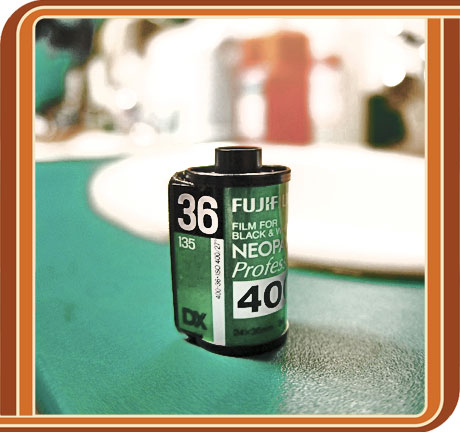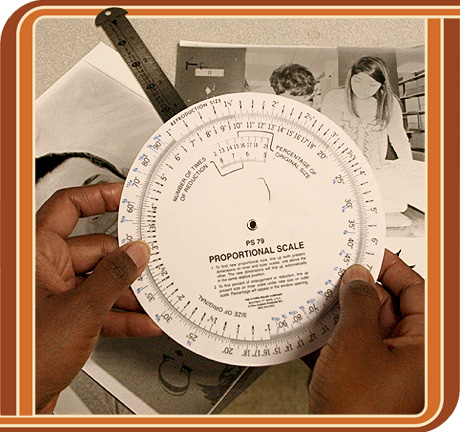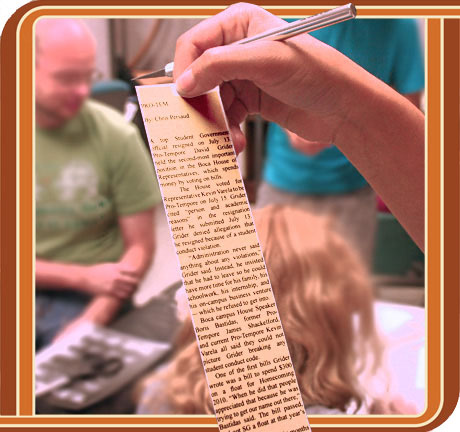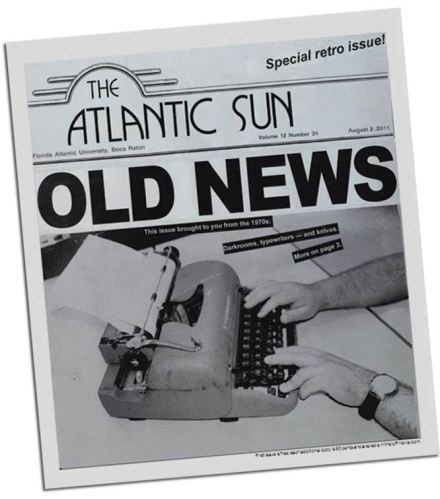Want to freak out a newsroom full of college journalists?
Sit them down at manual typewriters and ask them to plunk “2011” onto a piece of paper.
They’ll only make it halfway.
“Mine’s broken!” one reporter at Florida Atlantic University yelled a couple of Saturdays ago, when we launched the inaugural All On Paper project.
“There’s no number 1 key.”
“This one is busted, too!” yelled another.
“They’re not broken,” I replied. “Manual typewriters didn’t have a number 1 key. They used a lower-case L instead.”
“Seriously?” asked the first reporter. (Seriously. Click the photo below and look at the top row of keys.)
“That’s totally fucked up!” declared the second. Those same words have been repeated often these past two-and-a-half weeks, as we’ve embraced pre-computer technology to publish the last summer issue of FAU’s student newspaper, the University Press.
Some pessimists predicted All On Paper would be an exercise in futility. It’s proven to be a lesson in humility – for both the student journalists struggling with the old tech for the first time, and for the veteran journalists trying to recall how it all worked a few decades ago.
“Man, I forgot how much I forgot,” pro photographer Mike Rice whispered to me as he advised the photo students on how to set up a darkroom (which he did in a men’s room – more on that later).
Rice had a ratty old textbook stashed in his camera bag, which he referred to furtively and often. After all, one wrong mixture of chemicals, or one processing step out of order, and a roll of 35-mm film or piece of light-sensitive paper comes out blank. And neither of those items come cheap. (Thank you, SPJ, for giving us a grant.)

I, too, had trouble: How many words in a column inch again? How did I use this stupid proportion wheel once upon a time? And is the copyediting symbol for abbreviating, not abbreviating, spelling out a number, and using a numeral really all the same thing?
(Yup, you just circle the AP-Style-offending word or numeral, and the typesetter knows what the hell that means.)
So screw the students, here’s what I learned from All On Paper…
While archeologists try to recreate what life was like 10,000 years ago, and historians try to recreate what life was like 1,000 years ago, journalists can’t even recreate how they published a newspaper 20 years ago. No one documented the details or saved the old equipment. (I had to buy some of it from creepy old men through Craigslist.)
Journalists may write history’s first draft, but when it comes to covering their own history, they don’t even take notes. I can imagine college students 20 years from now asking their aged adviser…
Your digital cameras didn’t just beam images to the cloud as you shot them? What’s a “memory card”? And you had different programs for writing, design, and photo editing? Does anyone still have “Word,” “InDesign,” and “Photoshop”? It’d be fun publishing an issue that way – maybe we can buy copies from some creepy old men on Craigslist.
But what about the FAU students? What exactly did they do? And what exactly did they learn? Well…

1. Writing and reporting
After blowing their little minds with the missing number 1 keys, I still had to show the students how to set the typewriter margins.
(They enjoyed playing stupid and asking me questions like, “Who’s Marge?” Huh? “MARG RELEASE!” At least, I hope they were playing.)
Managing editor Mariam Aldhahi was stymied after typing her first line. “What do I do now?” she asked. “There’s no RETURN key.”
I pointed to the lever that would propel the carriage back to the left, while the gears inside would simultaneously ratchet the paper to the next line.
She tapped it lightly.
“No, this is a manual typewriter,” I told her. “You actually have to expend some calories.”
I slammed the lever to the right, and the carriage flew back to the left margin, stopping with a thud. A look of understanding, laced with horror, crossed her face.
“It’s going to be like this the entire time, isn’t it?”
“Not at all,” I said. “It gets worse.”
Worse was watching them edit their own stories.
In the pre-computer days, the easiest way to juggle paragraphs wasn’t retyping them – it was cutting them apart with an X-Acto blade and gluing them together in a different order.
This they did fairly well, after a comical and clumsy start. Mariam accidentally stabbed one of the reporters, but she didn’t draw blood. And no one tried to get high by huffing the rubber cement. (An improvement over my days at the University of Florida newspaper in the mid-’80s.)
One reporter, Mark Gibson, claims he got more done and had more fun using the old tech…
Technology, with all its advances in communication, keeps us further apart. Not being able to use email or cellphones forced us to be together in the newsroom every day. It was awesome having everyone there working together, and I felt like we accomplished more.
…and I don’t think he was huffing when he said it.

2. Shooting and processing
At least the writers wrestled with their typewriters in the newsroom. Photo editor Christine Capozziello spent two Saturdays in a little-used Student Union men’s room with Mike Rice.
Christine and Mike decided it was the only space big enough and dark enough – and with electricity and running water – to double as a darkroom. So they slapped an OUT OF ORDER sign on the door, duct-taped a red safelight to a urinal divider, and sat on the sticky floor making prints.
I thought it was gross, but Christine says it was “honestly pretty cool.”
“After a while I forgot I was even in a men’s bathroom,” she says. “I was just so preoccupied with developing the photos.” She learned a lot, and not just what a urinal cake is…
Having a hand in each step of the process was much more rewarding than instant digital photography. It feels much more like an art that way, which I loved.

3. Editing and copyediting
Just like the reporters have learned that “cut and paste” once involved actually cutting and pasting, the copyeditors have learned that the copydesk was once a real desk.
Our three copyeditors huddled in a corner of the newsroom, marking up stories with Ebony pencils and using copyediting symbols they learned from a cheat sheet consisting of carets, lines, brackets, and squiggles.
“Not having computers to verify the spelling of students’ names was the most inconvenient part,” copydesk chief Brandon Ballenger says. But there were advantages…
Showing the writers their heavily marked-up copy was more gratifying than sending back a digital doc with largely invisible changes – and hopefully it teaches them to write with more care.

4. Designing and sizing
Mariam, our managing editor, was previously our rock-star art director. So she resumed that role for All On Paper. Her designers mostly deserted her after they learned a terrifying reality of pre-computer layout…
You must do math.
First, there’s headline counting: A capital M is two, but a lower-case L (or is that the number 1?) is one-half. So how many counts do I have for a 48-point head across two columns?
Then there are the stories whose column inches must be distributed evenly across the page, requiring long division (without a calculator) and resulting in vaguely sexual newsroom directives like, “I need 11 inches to fill this box, and I need it now.”
Finally, there’s sizing photos with that confounded proportion wheel. Even though it’s supposed to help you shrink or enlarge a photo, and even though the instructions are printed right on the front, that God-awful wheel still doesn’t ever seem to give you the proper percentages. It’s more like a Magic 8-Ball than a round slide rule: much more mysterious than accurate.
“It’s been rough,” Mariam admits. “I’ve found myself sitting in silence, reminiscing about the days when CNTRL+Z was all it took. I miss my iMac.” But she also confesses…
Regardless of the stress or the obscene amount of paper that’s accumulated on the newsroom floor, I won’t forget what this project has given us. We’ve formed this sort of newsroom camaraderie that I hadn’t experienced before, and it means everything.

5. Typesetting and pasting up
The loudest “That’s totally fucked up!” came when the students learned everything they wrote on typewriters and edited in pencil would indeed be keyed into a computer.
Of course, at the dawn of the pagination era, that computer was a typesetting terminal filling up half a room and spitting out stories in long columns that had to be cut out and pasted up.
To mimic an ’80s-era Varityper, we set up a single iMac, keyed in all the stories in single columns, and ran them out on a laser printer. Then the paste-up artists trimmed and glued them to larger pieces of paper.
(In the old days, these “galleys” were run through a hot waxer. But not even the creepy old Craigslist guys had one for sale. So we used more rubber cement.)
The editors had the nifty idea of compelling the writers to paste up their own pages. That didn’t survive the first week. Many staffers learned that, while they can deftly manipulate a mouse to kill hundreds of bad guys in a videogame, few of them can draw a straight line. So Mariam and editor-in-chief Gideon Grudo did most of the paste-up.
Concluded Gideon…
After looking at a finished page – a page that took us half a day to finish – we felt so content and satisfied. I’ll compare it to the difference between buying a McNugget and hunting down your own chicken, gutting it, deboning it, and cutting it into nuggets.
Doing All On Paper all by yourself
If these students can do it, so can you. We still have the ancient equipment, and we didn’t use up all the pricey supplies. So if you want to try All On Paper – we suggest a four-page pullout rather than an entire issue – contact us for details.
Wondering how the issue looks? And how it reads? Click either cover…

…and if you read the previous All On Paper post, you might be wondering: Which cover did the student choose? Answer: Both.
At their request, I called the printer, and because this is an entirely black-and-white issue, he didn’t charge us for splitting the cover – half the press-run was “OLD NEWS,” the other half was “OMG WTF?”
If you want to see and hear what All On Paper was like, here are two outside takes. The first is from videographer Tatiana Cohen…
Then there’s this you-are-there slideshow from radio reporter Pam Geiser…
Finally, I’ll end with this weird but inspirational quote from FAU staffer Chris Persaud…
Technology hasn’t made us lazier, but it has made it possible to be lazier while still producing the same amount of quality work. Now that I’ve realized this, I know I’ll definitely be working faster to produce more quality news. And unlike the ancient civilizations of the 20th century, I’ve got the technology to do it.



